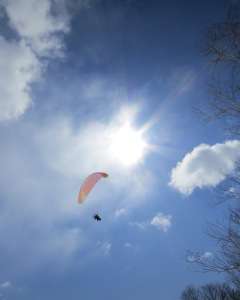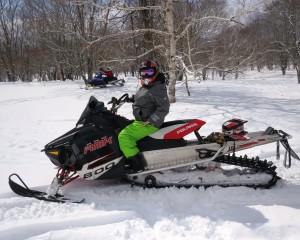JAPAN 2014
Japan Trip Report 2014
I’ve been fortunate to attend 2014 Japan ILTM – International Luxury Travel Mart. Only 60 travel professionals and journalists from all over the world were invited to come to Japan, meeting with suppliers and participate in most spectacular travel experiences.
March 11. I flew to Japan on JAL business class from Los Angeles. It was experience by itself and sure is the best way to get there with minimum stress and fatigue. Business class cabins had sky suites – your own private space. My seat unfolded into 180 degrees flat bed. At the head there was well designed and utilized space for plugging devices and usb ports to charge, quite large area for storage, very cozy, well designed. The wall was going up at click of the button to ensure privacy from your neighbor. TV was about 15 inches. Wi-Fi is available (I think also in coach class) for fee $10.95 1 hour, 19.95 whole flight.
I had a good sleep. JAL provided slippers, good blankets, extra pillow. I asked for extra pillow and flight attendant brought me memory pillow, very good. I chose not to work although space is comfortable. The lunch was served – Japanese and Western menu. Then throughout the flight, a la carte menu is available, order from your tv remote and send. I had 2 more small meals – sushi, Japanese udon noodle, ice cream. Toilets were toto! I was sorry the flight ended J.
I connected in Narita, spent 1 hr in business lounge, domestic terminal (you need to go through passport control, get suitcase and recheck it for domestic flight). Flight to New Chitose airport was 2 hours. It took a while longer because it was long runway wait. On arrival, to New Chitose airport, driver picked me and another trip participant and drove us to our hotel for a night, ANA Crowne Plaza in Chitose city. At this point I was 15 hours traveling and 13 hours time difference, so I just took shower and collapsed in comfortable bed.
March 13- 16, Hokkaido Island.
Hotel was 4* ANA Crown Plaza hotel in Chitose city. It is average 4* hotel, had free wifi with cable connection in the room and wireless in the lobby. Lots of airline crew here. It had nice buffet breakfast with Japanese specialties. I am only spending one night here since Chitose city obviously is not much to do except a jumping point to Hokkaido attractions.
At 9:30am, myself and another fam trip participant Joel, met with Hokkaido tourism organizers who will be with us on this trip. Third person from Singapore was arriving today so we went to meet her in airport. The time was arranged so we will inspect airport and at the same time meet more tourist representatives. Yuki is the travel agent who would spend whole 3 days with us. There were also her boss Mr. Yamato, her associate Akiko and guide Yass. I thought – what is there to see in airport? Wrong! We met third participant Anglia from Singapore. Then we went to the business lounge and met with airport representatives there. Nice, but not much different from other international airport lounges. Then, we walked into mall area and I was surprised to see many stores and shopping mall and variety of restaurants. 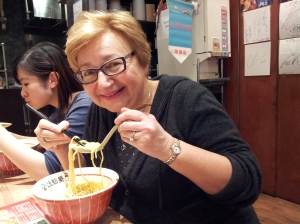 There was even ramen row where was a choice of Ramen noodle places to eat. We had reservation at one of these places. Yass explained different types of ramen and I settled on “special of the day”. It was noodles with miso, seafood and vegetables. Basically one meal in a bowl. It was very good.
There was even ramen row where was a choice of Ramen noodle places to eat. We had reservation at one of these places. Yass explained different types of ramen and I settled on “special of the day”. It was noodles with miso, seafood and vegetables. Basically one meal in a bowl. It was very good.
Then we went to see shops and spent some time in Ainu culture store-museum which was our theme of our day. Yass explained some items and said more will be told on the way.
Before I came, I read on airport website that they have a spa. I mentioned this to Yuki and she took us to see it. Very interesting – there is thermal spring – one of many springs on the island – in airport area. Japan is famous with onsen spas – based on mineral springs thermal waters. Yuki said this one specifically built as a spa, not airport facility so even local Chitose residents come to visit it. There are lockers, bath facilities and restaurant. There is a quiet resting room where people can spend a time between flights and even a night if their flight is early next morning. They sleep on reclining chairs. Besides communal rest room, there is also small hotel with about 10 rooms if you want a room with a real bed.
This airport even had a cinema theater, so it is definitely a comfortable space to spend time between flights.
After visit to the spa, we met representative from Ainu village, husband and wife couple, Kenji is Japanese man who married Maki, Ainu woman.
Ainu people, means “human”. They regard things useful to them or beyond their control as kamuy”(gods). These are indigenous people in Japan (Hokkaido island) and Russia (Sakhalin and Kuril Islands). The Ainu people believe that each entity comes from its own world and returns there after accomplishing its role.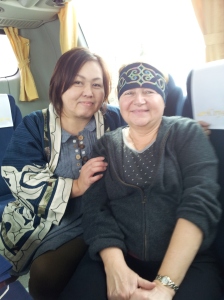
It is considered that Ainu culture as it is known today was established around the 13th century. But there is an evidence of traces of Ainu civilization about 300 bc.
The Ainu believe in the interaction of nature, humans and the gods, and they utilize the nature around them for clothing, food and housing, and never take a life unnecessarily. Fish, bear meat and wild plants are gathered and stored in preparation for winter and times of famine.
As minority with different religion, they remained oppressed and exploited by the Japanese until the Meiji era. In the late Meiji era, with an increasing number of Japanese colonizing Hokkaido, the oppression and exploitation of the Ainu was replaced by discrimination against them. In 1899, the Hokkaido Aborigine Protection Act was passed. The act primarily aimed to provide relief for the Ainu and help them become engaged in agriculture. The act designated the Ainu as “former aborigines” and clarified the distinction between the Japanese and the Ainu. At the Hokkaido Ainu Convention in Shizunai, Hokkaido, in 1946, the Hokkaido Ainu Association was established primarily to provide higher education and collaborate in the construction of social welfare facilities.
Nowadays, various activities are being vigorously promoted to revive the Ainu language and to preserve and maintain Ainu culture, such as traditional dancing and various ceremonies. Ainu language classes are being held in various parts of Hokkaido. Kenji and Maki are such educators and advocates of Ainu culture.
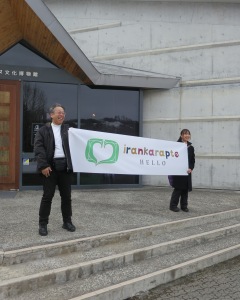 This is what we’ve heard on the way to Ainu village as we traveled by the bus from airport to Biratori town, where on arrival we visited museum Nibutani Ainu culture museum with exhibits of Ainu people’s life and customs and their artwork. As we exited the b
This is what we’ve heard on the way to Ainu village as we traveled by the bus from airport to Biratori town, where on arrival we visited museum Nibutani Ainu culture museum with exhibits of Ainu people’s life and customs and their artwork. As we exited the b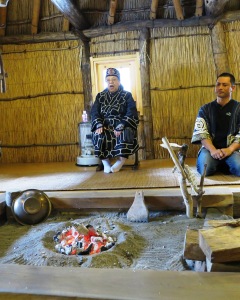 us, we’ve met by Ainu museum representatives and again Mr. Yamato and Akiko who were holding banner “ILTM Welcome!”
us, we’ve met by Ainu museum representatives and again Mr. Yamato and Akiko who were holding banner “ILTM Welcome!”
Museum had interesting exhibits describing their way of life. There were also some houses outside. We also met an old Ainu woman who sang Ainu songs for us and Kenji and Maki translated. Afterwards we went to Maki house to meet her relatives including her mother who was weaving cloth for kimono from bark tree. We were explained the process of weaving and material making, it is very time consuming, that’s why clothes made by Ainu is very unique, all natural, handmade and expensive. Also Maki’s brother showed us how handmade wooden craft are made, also very delicate work.
We had snack at Maki’s house of boiled reindeer with seasoned salt. Simple but delicious.
It was time to depart to our Hotel Lake Shukotsu Tsuruga Onsen resort http://www.mizunouta.com/en/ which is located in a forest of pristine Lake Shikotsu. The theme of the resort utilizing Ainu concept “The healing power of water”. On arrival, resort staff came out to meet our bus. We were ushered into the welcome lounge, removed shoes. At the center of the welcome lounge is a suikinkutsu, a t type of Japanese garden ornament and music device, which stands as a tribute to the hotel’s name MIZU NO UTA, or the song of water. The gentle, comforting sound of echoing water also flows into the corridor leading to the guestroom wing, marking the beginning of a getaway soothed by the power of water. It had a feeling of homey open space with fireplace in the middle where you can roast marshmallows. There were beautiful sculptures with Ainu theme.
It is shoeless zone so you remove your shoes at entrance of resort and use their slippers or Japanese shoes. It was very clean and pleasant to wear only socks and in some areas I felt heat of the floor.
After brief orientation, we visited resort’s facilities. What was interesting I saw in the gym area – warm up room and cool down room to do it before and after exercise.
Another worth of mentioning is “Pillow concierge” where you test and choose pillows of your choice and then it is delivered to your room.
My advice to travelers in Japan – bring less shoes and more nice looking socks J.
My spacious room had private onsen outside, in the room there was a massage chair and coffee maker area. The resort provided comfortable pajama (yukata), slippers and a warmer robe to walk outside. There is a brief outside walk to the restaurant. The dining in yukata is encouraged for comfort of guests. We agreed to meet in half an hour for dinner. It was kind of awkward to sit in pajamas while our hosts (representatives of Hokkaido travel and resort) were in business clothes but we got used to it. Dinner was delicious local organic produce, traditional Japanese kaiseki cuisine. After dinner our friends Kenji and Make appeared with the Ainu dance group and they performed Ainu dances. We were given traditional Ainu headbands and joined in the dance. Everyone had fun! We were too full and tired to have desert and the restaurant thoughtfully suggested they will deliver it to our rooms.
 Returning to my room, I tried onsen outside, the temperature was 90F and it was incredible to sit in the hot tub with snow outside. The skin felt so good after that. The desert was delivered just before that, so tea with desert in comfort of my room was just what I need to conclude my first day in Hokkaido.
Returning to my room, I tried onsen outside, the temperature was 90F and it was incredible to sit in the hot tub with snow outside. The skin felt so good after that. The desert was delivered just before that, so tea with desert in comfort of my room was just what I need to conclude my first day in Hokkaido.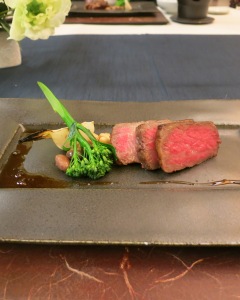
In the morning, I woke up early still due to jet lag, to experience Onsen one more time at sunrise, it was unbelievable experience. Too bad we move to the next place but I have mental note to come back again and enjoy this resort in the fullest. I did not even try spa here!
I went to restaurant for breakfast. The spread consisted of delicious variety Japanese and Western items. The vegetables especially small tomatoes were very tasteful. There were variety of different fresh squeeze juices with fruit and vegetable pulp and they tasted deliciously. I guess juices depend on quality of fruits and vegetables.
After breakfast we’ve met again with hosting team in the meeting room for presentation on Hokkaido and resort in particular. We have found out that Tsuruga group, a local family owned company, has 10 unique hotels and resorts in Hokkaido, being in total harmony with nature, history and culture of the island. Hokkaido is Japan’s biggest island on the north, and it most of its treasured places are various lakes and forests. It consists of 5 hundred islands, volcanoes, and boasts incredible nature at any time of the year. It has 6 national parks with various flora and fauna, numerous volcanoes which result in geothermal activities. That means many onsens for mineral water bathing. Largest city is Sapporo. We were located in the southeast area not far from Sapporo.
After presentation and discussion, we went for a walk around snow covered Lake Shikotsu. We were given special knuckles on boots to prevent us from slipping. Very thoughtful. The views of the snow covered lake was beautiful but I imagine how nice it is in any time of the year. The snow was so clean that it had blue glow just like glacier snow.
Afterwards we were ready to leave. Today we had a new luxury bus provided by star limousine www.cool-star.jp . It was a small minivan with seats on the side conference style and it has a bus attendant who served drinks, took coats and made sure we were comfortabl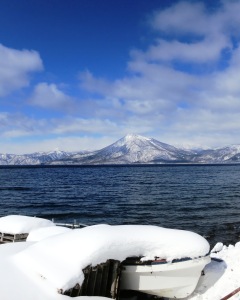 e. It also had bathrooms with toto toilet. Our delightful bus attendant changed every day a little snowman’s flag with current information on weather.
e. It also had bathrooms with toto toilet. Our delightful bus attendant changed every day a little snowman’s flag with current information on weather.
The trip to our next destination, Niseko ski area took about 1 hour and we had discussion on the bus. Yass and Yuki let us use their wifi but I do not think it is a problem to get a bus with wifi for meeting if needed.
We have arrived Niseko and had lunch in local restaurant Lupicia , it is a fusion Japanese-Western cuisine. The company which owns restaurant are also producers of fine teas so besides delicious Western lunch, we also tried desert buffet and finished with tea. First we did wine and cheese sampling, and the wine supplied was delicious Gewürztraminer paired with local cheeses. The appetizer was a local oyster, followed by dish of scallops, beautifully presented. Deserts were buffet selections of small pastries. I
liked their Sakura tea so much so I bought few tins to take home. You can also buy it online in USA. Lunch was nice variety from Japanese Kaiseki dinners and also featured local specialties.
The Niseko area boasts best food in Japan, thanks to diverse local produce and seafood, in additions to well known Japanese precision, presentation and quality.
To my questions re: seafood and nuclear disaster, I was told, that though the area is far to the north of Fukushima, but still the local chefs are still vigilant about food quality in light of the disaster and they conduct their own testing and inspections by government and private companies. According to local authorities and restaurant owners the safety issue is something restaurant owners are aware of, but luckily the damage has been limited and food is safe to consume. This is true to all areas of Japan outside of Fukushima but Hokkaido in particular is the most northern island further from disaster.
After lunch, we left for a meeting with Hokkaido Tracks Company in Niseko.
Niseko is a Mountain resort Grand Hirafu which is famous for its “champagne” powder snow and extensive slopes. Result of low pressure systems over northeast Hokkaido meeting high pressure systems over northwest Siberia. The winds from Siberia pick up moisture from the Sea of Japan, and the resulting bands of clouds dump huge amounts of snow when they reach the mountains.
This mountain resort is located at the foot of the mountain and provides skiing and other snow activities, nice international dining, nightlife. In Niseko, unlike in Chitose and Lake Shikotsu, it was predominantly English speaking as most suppliers and tourists were from Australia and New Zealand. Accommodations are mostly chalets and condos. We were given presentation on a new luxury condo resort which will be opening next year and also saw existing condos. The company is called Hokkaido tracks and I believe owned (or managed) by Australians. Condos were very nice and comfortable with special storage for skis.
Demographics are: Australian skiers, Japanese families and the Asian well heeled families. This is the Asian version of Aspen, St. Moritz or Courchevel – you will find an excellent upscale condos and high-end restaurants. The infrastructure of the town is still that of a small village, not of a fancy winter resort.
In summer, we were told, many activities for biking, hiking, summer gondola, walking trails. There are beautiful flowers including lavender which provide beautiful colored landscape in summer. The area boasts 6 National Parks with diverse flora and fauna. I saw beautiful photos of Hokkaido in summer with lavender and multi-color fields, fall colors and blossoms of the spring. Various volcanoes supply natural hot springs, so there are everywhere onsens with thermal bath. Fishing, bird watching, interesting local animals (pinguins, cranes, monkeys who love to swim in thermal waters are just a sample of few fauna representatives).
After presentation, we were driven to our hotel nearby, Chalet Ivy, a 4* new boutique hotel in the center of the mountain village. It is about 3 minute walk to the Ski center. We looked at few rooms and hotel facilities and they were very nice, most colors in white, minimalistic design. My room was a suite with an extra dining area and view of ski lift. Hotel has onsen on site, and some rooms also have onsen thermal water. Mine room did not have it and we planned to go to onsen in the evening. It also had some complimentary local spring water from Mt Yotel, teas and coffees and some power bar which I found very delicious. The room had all comfort of Japanese hotel including Yukata, slippers and toto toilet.
I hurried downstairs to get fitted into my snow clothes. This included bulky snow boots, ski jackets and pants. I had to try quite few suits to find my size. At the end I saw that I got grey pants and green jacket and Yass got matching green pants and grey jacket. We laughed. See Photo on right.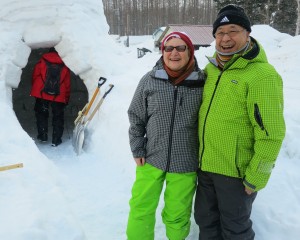
On arrival to BBQ location we were showed by property ownerto igloo. It was already built thankfully but needed final touches. We chiseled snow inside to get it ready for the table for dinner and made some niches in the snow walls for candles. Someone brought in sigh igloo café. We’ve had fun and lots of photos and even made a snow man. The BBQ meanwhile was ready and we had it in the igloo. There was indeed a building on the property (event house, former school)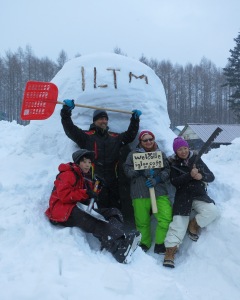 so we were able to warm up later on by fireplace. After short ride to hotel, I had too much fresh air, onsen sounded inviting, but it was public and I was too tired to go there and just went to sleep so I just went to bed.
so we were able to warm up later on by fireplace. After short ride to hotel, I had too much fresh air, onsen sounded inviting, but it was public and I was too tired to go there and just went to sleep so I just went to bed.
Next morning, I came down for breakfast. It was not that elaborate as in Tsuruga resort, but good selection of local products and cooked to order eggs. After breakfast, we left for next snow activity – snowmobiling and motor power gliding. On arrival to snowmobiling center, we were outfitted with helmets and protective glasses and we had about 1 hour snowmobile ride in a beautiful, pristine snow forest. The instructor led the group. After that there was motor gliding, where you are hooked together with instructor, run with the wind and then when the wind is right, instructor turns on motor. Something like parasailing but running until you take off. I said will wait until my two teammates will do it and see how they land, then I might consider it. Unfortunately, the wind did not cooperate and the activity has been cancelled. Yuki suggested walking across the street to well known ice cream store where we sampled delicious ice cream from local cows. The scenery and food reminded me of Switzerland.
We returned to the BBQ Igloo owner since he wanted to show us birch and maple sap derived from his trees. The juice was delicious and what maple juice / syrup is not sweet like in North America. I had birch juice often when I was growing up in Ukraine but I did not see it in North America. That taste was familiar. But Maple sap was completely different taste, not that sweet at all. We were told, both saps have health benefits.
Back to hotel, we returned our snow gear and put on back our regular clothes. Then we had a working lunch and discussion with representatives of Niseko tourism at our hotel Chalet Ivy. Nice wine has been served with sushi, salad, some squash bisque and desert was a fruit salad in grapefruit skin.
See photos
After lunch we checked out and left Niseko for Asarigawa Onsen ryokan “Kuramure”. On the way, we munched on delicious cream puffs bought in Niseko and bus attendant served tea and drinks. On arrival to Kuramure, the staff lined up outside to greet us. It was indeed very nice ryokan with excellent service, and onsen on site. We removed shoes and seated with green tea. In this ryokan, everything was included, even drinks at the bar. My room was a suite with separate tatami room (Japanese style) but it also had bedroom Western style bed. My room had yakata pajama, to sleep and another one to dine, and there was an assortment of drinks in the refrigerator. The bathtub had a faucet for onsen water, which did wonders for my tired muscles after all snow activities.
The ryokan is very interesting since it is in style of a warehouse – dark walls and small windows (but enough lights). My suite was on 2 different levels. The hallways are somewhat dark, but hotel has this design feeling. We had dinner with hotel owner, Katsuko Takamura. It was delicious multi course kaiseki dinner. We discussed hotel, food and Japanese life. Hokkaido is a mecca for not just gourmet travelers but who likes to eat local grown organic food. Here is a link to the photos. Started with Apricot liquor aperitif and Monkish liver Tofu (yellow color in the center on small elevated plate). Hors d’oeuvre – long plate front. Oyster from Akkeshi – very fresh local Hokkaido, Hair crab – also local, cooked and frozen on the boat to keep freshness and unique juiciness. Such crabs are only in Japan and Russia. Decoration and vegetable purple – lotus root. Then followed Hor’s D’oeuvre (Zenai) , sashimi – medium fat tuna, and Jumbo shrimp. Then Lily bulb and steamed shrimp. The lily bulb texture for some reason I did not like. .. I was encouraged to eat but the texture did not appeal to me. At least I tried. I had it day before as fried pancake and I liked it better. Very soft consistency something like sweetbreads but from the seafood.
Afterwards was server sake appetizer – Shiraoili beef with onion sauce, local beef, very tender. The dishes were paired with 4 types of Sake. Palette refresher was Citrus sauce Sea Cucumber .
Last two entrees were Tempura of Abalone with Botargo salt. I liked this fish a lot. Botargo salt – special type) I am very particular with salts) came from Peru Sacred Valley. Bowl dish was skitfish with snow peas. The snow pea pod turned out very spicy!
There was one dish of pickled vegetables. I love these (every Russian does pickled veggies). This came with miso soup and excellent rice but I did not take pictures of them. Rice was organic rice specially grown by Mr. Kikuchi Makoto in Ginzan, Niki township Desert was familiar Western – made from delicious local milk – ice cream
Here are some photos of this memorable dinner.
We retired to rooms and I try one more onsen bath before I fell asleep.
Next morning, even though breakfast was included, Yuki scheduled something else for us. We had coffee at hotel’s bar (excellent!) and left for Itaru fish market. After fish market visit, we had breakfast there with market owner. The breakfast was a sample of seafood what Otaru offers – fried, raw, steamed – you can name it, we had it. Hairy crab was delicious. 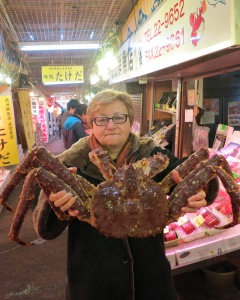
https://www.facebook.com/sophiastravel/media_set?set=a.10152333911609878.1073741857.717049877&type=3
After that we went to Sake factory where we had presentation on sake processing. Then we walked Otaru city – there were interesting s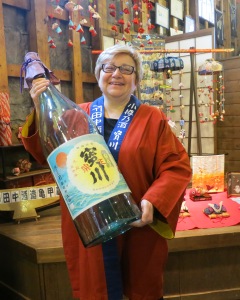 tores, with beautiful local glass, sweet shop stores, it was very pleasant walk. We saw Otaru canal in the middle of the city. Lunch was at Soba house, a restaurant held by 15th generation owner. Everything in this Soba restaurant was from soba – salad with soba sprouts, soba noodles, and even soba green ice cream. It was like mini kaiseki soba lunch. We talked to the owner who filled us in on situation in the city and his leading effort to save Otaru Canal.
tores, with beautiful local glass, sweet shop stores, it was very pleasant walk. We saw Otaru canal in the middle of the city. Lunch was at Soba house, a restaurant held by 15th generation owner. Everything in this Soba restaurant was from soba – salad with soba sprouts, soba noodles, and even soba green ice cream. It was like mini kaiseki soba lunch. We talked to the owner who filled us in on situation in the city and his leading effort to save Otaru Canal.
After that, it was time to go to airport to fly to Kyoto. Yuki and her team saw us to airport, helped to check in and we were on the way to Kyoto. It took about 1.5 hours to arrive to Kansei airport and on arrival , about 6pm, a driver met us and transferred to hotels. All three of us stayed in separate hotels. Mine was Hyatt regency Kyoto. On arrival, I saw many people in the lobby and the receptionist told me it is the Sunday, is a wedding day. The ladies in Kimono and brides in western white dresses were very beautiful. My room was comfortable but smaller than my hotels in Hokkaido. It will be my home for next 4 days, so now I can unpack and prepare for an ILTM Japan conference. Most attendees are arriving tomorrow. I considered going for light dinner, but hotel supplied welcome fruit and sweets and water, and I did not want to be in the middle of weddings, so I just stayed in the room and caught up on my emails.
March 16-20, Kyoto
Next morning, I went downstairs to have breakfast. Hyatt has two restaurants for breakfast – Western and Japanese. I chose Japanese, for its serenity and food delivered in a tray to the table instead of Western buffet. I was not sure what I get but whatever I got was delicious. Cold soy milk was delicious and I usually do not drink it at home.
At 9am, I’ve met a guide at hotel’s lobby and we left for a tour of Kyoto. We picked up other ILTM participants at other hotels and she gave us a little tour of the city from the minibus. We arrived to the temple where we’ve met a monk who showed us around temple, explained the importance of Japanese landscaping, and gardens for meditation. We admired beautiful Japanese art on the walls, gardens and did 15 minute meditation.
After that, we continued to another temple to continue our Zen experience where we had a beautifully presented vegetarian kaiseki lunch and a lecture on this healthy and balanced food.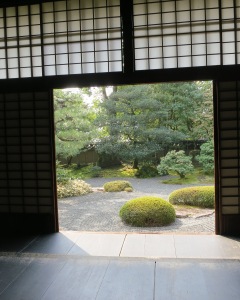
After Zen experience, we went to another Sake brewery to sample Sake. We came back to hotel about 4pm just in time to refresh and to get ready for ILTM Opening. Luckily it was in new History museum across the street from my hotel so I just walked there.
Here is a video of brewery
I’ve met there again my friends from Hokkaido. After opening remarks, there was an interesting speech by one of Japan’s leading economists, Hitoshi Yoshimura. Then, luxury travel guru and writer, Mary Gostelow from UK, presented best luxury hotels and the trend of the future. This followed discussion panel by international journalists. After forum, we went to Hyatt for a party. As usual with ILTM, it was very well organized party with suppliers, buyers and journalist mixing together. Japan event was much smaller so we had more opportunity to communicate. My new friends from Hokkaido were there as well.
Mayor of Kyoto came to the party and gave a welcome speech. He was dressed in traditional male kimono and took of “jacket” to show interesting design. Our guide Mia who was with us in the morning, was his translator. She was wearing beautiful kimono as well. Later on, I exchanged cards with mayor of Kyoto! There were traditional Japanese dancers.
Here is a video of Mayor of Kyoto .
Third day, we started conference, full day meeting with suppliers one to one. Many already I’ve met but I’ve got formal presentations about new interesting products. It was exciting to reconnect with old suppliers and meet new ones. Venue also was very unusual. Unlike in other countries which usually have events like this in convention center and that was what we’ve expected, but SODOH was in a historic mansion house. Originally was owned by artist, now it became a restaurant and place for events, Located in traditional neighborhood Higashyama, it is surrounded by 2 temples, pagoda and interesting small streets. Since we had 1.5 hour for lunch, I finished quickly my bento box lunch and set out to explore. I went to Kodaji beautiful temple and had nice walk in its gardens. The weather was great. Then I browsed traditional streets with Buddha statues and stores. Many people were wearing traditional clothes and they loved their pictures to be taken. I got some really nice photos.
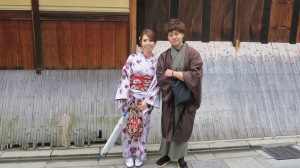 This evening, the party was
This evening, the party was 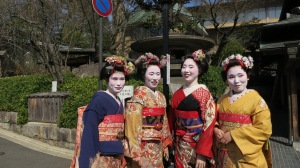 in a new Ritz Carlton Kyoto. It just opened a month ago and it was spectacular hotel and considered now a top hotel in city. It had really nice suites with terrace and gardens for each suite. Unlike other Ritz Carltons, this one is more like luxury ryokan, only 3 story high and built on the banks of Kanagawa River.
in a new Ritz Carlton Kyoto. It just opened a month ago and it was spectacular hotel and considered now a top hotel in city. It had really nice suites with terrace and gardens for each suite. Unlike other Ritz Carltons, this one is more like luxury ryokan, only 3 story high and built on the banks of Kanagawa River.
Third day,
I had breakfast with my supplier who was not exhibiting on ILTM but the owner Avi originally from Israel, now runs luxury company in Kyoto and we had a breakfast together discussing opportunities for Jewish travelers. While not much, still Japan has some interesting history connected with Jewish people and holocaust.
Then I went upstairs and packed my large suitcase to send it to my hotel in Tokyo. This service exists only in Japan and it is a great convenience for passengers traveling by train. I left a phone with concierge and they said it will arrive next day about same time as me to my hotel Conrad in Tokyo.
Second day at ILTM finished at 5pm and I went back to hotel after closing cocktails, and met with Avi for a fascinating walk in Gion where he explained to me about Geishas, Maike (apprentice Geisha). I’ve met geishas before on event in Tokyo few years ago, and also Geishas came to our party yesterday, so I already had pictures with them. We did not want to spend time and money to go for Geisha’s private entertainment like our clients do, so we just walked the district and Avi knew place and time where they go for work around 5:30pm so we walked there and took nice photos. Afterwards, we went to local small restaurant for delicious grilled meat and vegetables dinner.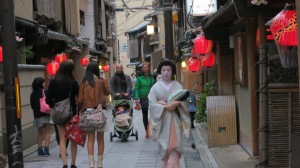
Said goodbye to Avi, he dropped me at hotel and packed my small bag for tomorrow travel to Tokyo. In the morning, I went to temple next to my hotel. It was very interesting temple, without thousands of Buddha statues (no photos allowed there). Then I checked out and the car arrived for me to take me to train station where I bought a ticket on shinkasen (high speed train) to Tokyo. Shinkasen high speed bullet train is a marvel of engineering. I love European trains, but this train is so much comfortable, faster and efficient. Japanese even though about feet warmers! I loved my train ride in first class. I was hoping to see Mt. Fuji but the weather did not cooperate. I’ve met another agent from ILTM on the train (from different hotel in Kyoto) so we caught together a taxi from Tokyo train station to hotel Conrad.
Here is a link to my Geisha’s performance video.
March 20-22, Tokyo
 Conrad Tokyo is a beautiful 5* hotel in excellent shopping location – Ginza. It opened in 2005, so it is relatively new. Like most buildings in Tokyo, it shares high rise building. Located in Shiodome building, on 28-37 floors. You need to go to lobby and take elevator to “first floor” which in reality is 28. From there you go to your floor. Shiodome is a very futuristic area of skyscrapers and connecting skywalks, elevators, and escalators.
Conrad Tokyo is a beautiful 5* hotel in excellent shopping location – Ginza. It opened in 2005, so it is relatively new. Like most buildings in Tokyo, it shares high rise building. Located in Shiodome building, on 28-37 floors. You need to go to lobby and take elevator to “first floor” which in reality is 28. From there you go to your floor. Shiodome is a very futuristic area of skyscrapers and connecting skywalks, elevators, and escalators. 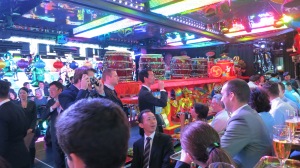 The usual Western city orientation mentality does not work here, you just need to follow signs – streets are very well signed and posted in English as well and maps are available. It is also close to Tsukiji fish market which I visited in my previous visits, so I did not intend to go there at 4am. But it is highly recommended for first time in Tokyo to see tuna action if you can and have sushi breakfast.
The usual Western city orientation mentality does not work here, you just need to follow signs – streets are very well signed and posted in English as well and maps are available. It is also close to Tsukiji fish market which I visited in my previous visits, so I did not intend to go there at 4am. But it is highly recommended for first time in Tokyo to see tuna action if you can and have sushi breakfast.
My suitcase arrived the same time as I and was delivered to my room. So far travel in Japan is a delight. I had a nice room with open view from the bathroom (glass wall), from 33rd floor I see a Hamarikyi garden and Tokyo harbor below. I did find out that the open glass wall of the bathroom has a curtain so it does provide privacy for guests who needs it.
I went for 6 pm reception at one of the Conrad suites where we’ve met hotel managers and other local tour operators. One of the advantages of such events that we get to know General Managers and sale people at hotels and this really helps to serve our clients better with right connections.
Food was samples from hotel’s restaurants – Japanese and Western and one of the restaurants has Michelin star. After great time was had by all, we went for a surprise activity in Shinjuki. It was a show by robots. We were warned before to eat cocktail food since the show did not have good food there. It was very strange show, but I guess I will never see it before. Lots of bright colors, neon’s, loud music, combination of mechanical robots and dancers dressed up in robot costume. The costumes are strange and surreal, but it was fun to watch it.
The bus took us home. Next day I had to myself so I just wondered streets of Ginza, went to gardens near hotel. For lunch I just snacked on the streets (Belgian waffles as fast food was delicious!). At end of the day, I was craving for simple chicken, so I found some restaurants below Conrad in the mall and had something like teppaniyaki chicken.
That was my last day in Japan and next day I took a bus to airport ($30 usd, leaves direct from Conrad – comparing to $250 taxi ride). JAL lounge was terrific, again, better than any other business lounges I had in the world, I did leftover shopping in Narita airport and had comfortable flight in Business class back to Los Angeles. Farewell Japan, I hope to come back soon!
Final thoughts and tips
I love Japan. It is different from other Asian countries – more expensive, yes, but it is more upscale, and provides excellent service and value for money paid. Tips are not expected.
My best experience this time – new destination was Hokkaido. Niseko was amazing snow destination – it is Japan’s St. Moritz but without St. Moritz prices and with excellent Japanese food and quality. Also if you mix Hokkaido into your Japan trip, the cost will improve since as of now, Hokkaido is not that expensive as Tokyo and major Japanese cities.
Food is amazing anywhere we went. From simple street food to elaborate Kaiseke dinners to Michelin star restaurants in large cities – Japan has it all. If you like Japanese food in USA, you will enjoy it in Japan, however, I can warn you – it is not the same. For example, Japanese do not know about our “sushi rolls” and “Hibachi dinners” . I had to google and show them pictures. They never saw something like Hibachi entertainment. We think it is somehow American restaurateurs needed to attract families and they created something like “tapaniyaki” (cook at the table) and cross with samurai’s knives and fire. Japanese never eat sushi rolls with smoked salmon and cream cheese for example. They know about California sushi rolls but for food presented to us it was shown “this is not your California rolls” J
Having said that, you do not need to eat sushi and fish all the time. Western food is widely available. Even Macdonals you can find in large cities.
Phone and electronics – first time when I came, my USD phone did not work there. This time 4G network worked. The chargers also do not need special plugs but different electricity – worked with my laptop, playbook and phone. However when I came back my phone for some reason was messed and could not charge. Eventually I fixed it. Not sure if it was related to different electricity or not.
Cash – surprisingly for high tech level of the country, still it is not easy to get cash from ATM, they are only available in 7-11 stores which are pretty much available everywhere but you just need to remember to get cash there. Smaller restaurants in non-touristy places did not take credit card. I ended up changing money few times at hotel.
Also 7-11 and Lawson are their convenience stores where you can buy all necessary items and food when you need it. Open 24 hours.
There is language barrier so guide is strongly recommended to enrich your touring experience. If you cannot afford guide and driver in the city, take at least guide and use public transportation with him/her. In countryside we get for our clients driver/guide in one person to save money but there are not too many of them. Tokyo is the most international city where you can get buy in some cases with English only but I always print or take hotel’s card in Japanese to ask for directions or give to taxi driver. The problem with letters that these beautifully written letters do not make sense to western traveler.
Airport transfers – Narita is further from center than Haneda so transfers are more expensive. If you have a choice, closer and cheaper to fly to Haneda. Airport express is less expensive and comfortable way to get to the city center and take taxi from there. From some hotels like Conrad, airport express was on bus stop. Taxi is about $250 depending on hotel.
Trains are very comfortable, if you go to cities by train, it is recommended to get Japan Rail Pass. Easy to use – just show to the conductor. Same applies to the city transportation card.
People are very friendly. It said you cannot lost in Japan because locals will try to save you. However, not everyone speaks English so it is a bit hard with language communications. But people are very nice.
Special events : Cherry Blossom festival in April . But any time it is good to visit Japan.
Contact us for your trip to Japan info@mytravelfind.com
For more photos, see my slideshow
Disclaimer: this report presents just an opinion of individuals who’ve been there…. Tastes Differ…
Copyright 2014 Sophia’s Travel Agency, division of EMCO Travel, LLC..

